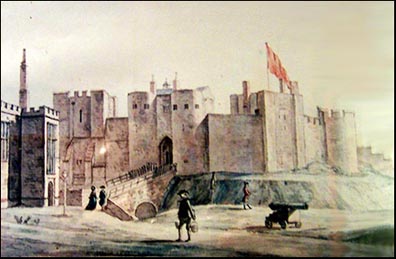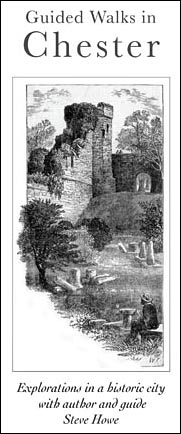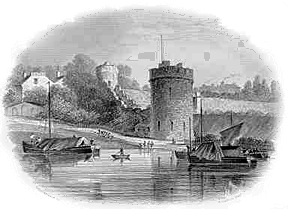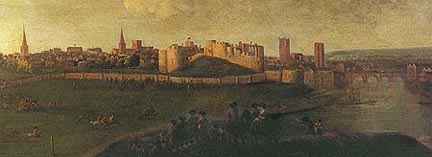  n
1696,
a
mint
was
set
up
in
Chester.
This
was
part
of
an
effort
to
completely
renew
the
nation's
currency,
and
the
man
put
in
charge
in
London
was
one Isaac
Newton (later
knighted
for
these
efforts,
but
not
for
his
science). n
1696,
a
mint
was
set
up
in
Chester.
This
was
part
of
an
effort
to
completely
renew
the
nation's
currency,
and
the
man
put
in
charge
in
London
was
one Isaac
Newton (later
knighted
for
these
efforts,
but
not
for
his
science).
To
take
charge
of
the
Chester
mint
he
appointed
the
great
scientist
and
astronomer Edmond
Halley (he
of
comet
fame),
who
spent
two
years
at
the
mint
in Chester
Castle (the
site
is
marked
on
the
signs
put
up
by
English
Heritage-
just
behind
the
Half
Moon
tower).
Halley
was
a
remarkable
man.
It
was
he
who
persuaded
Newton
to
write
his
most
famous
work,
the Principia and
the
Royal
Society
to
publish
it.
In
fact,
Halley
paid
for
the
publication
himself.
He
arrived
in
Chester
fresh
from
salvage
work
in
a
diving
bell
he
invented,
and
left
in
1698
to
captain
a
Navy
ship
(the
only
civilian
ever
to
do
so)
in
two
voyages
around
the
Atlantic,
mapping
magnetic
variations,
and
then
in
the
English
channel
mapping
tides
(his
tidal
chart
was
the
first
of
its
kind
by
over
100
years),
later
succeeding John
Flamsteed to
become
the
second
Astronomer
Royal.
 While
in
Chester
he
wrote
several
letters
to
the
Royal
Society,
printed
in Philosophical
Transactions describing,
among
other
things,
the
Roman
altar
found
in Eastgate
Street.
He
added, While
in
Chester
he
wrote
several
letters
to
the
Royal
Society,
printed
in Philosophical
Transactions describing,
among
other
things,
the
Roman
altar
found
in Eastgate
Street.
He
added,
"The
Stone
of
this
place,
which
is
soft,
reddish,
grit,
and
very
friable,
with
shining
particles
intermixt,
is
very
apt
to
decay
with
the
weather,
so
that
all
Old
Buildings
are
very
much
defaced
thereby,
and
the
Walls
which
are
Built
thereof,
are
so
frequently
out
of
repair
that
they
have
Officers
on
purpose,
whom
they
call
Murengers,
who
do
gradually
refit
them,
where
they
are
most
worn
out;
in
some
places
the
Stone
is
in
a
manner
moulded
away
like
Sammel
Bricks
in
a
Wall,
leaving
the
Mortar
standing.
In
these
Stones,
and
the
Quarries
from
whence
they
came,
I
have
diligently
sought
for
Shells
or
other
Animal
Substances,
such
as
are
often
found
in
other
places,
but
hitherto
have
found
no
such
things:
But
the
Stone
is
generally
intersperst
with
Pebbles
and
small
Flints,
which,
as
the
Stone
decays,
do
discover
themselves
within
it,
as
if
they
had
been
lodged
in
the
Sand,
whereof
the
Stone
consists
before
its
Induration"
He
also
describes
a
hailstorm
which
affected
North
Wales,
West
Kirkby
on
the
"Wirall",
and
parts
of
the
North
of
England,
observations
of
an
eclipse
of
the
Moon,
experiments
showing
the
effect
of
altitude
on
air
pressure
conducted
on
Mount
Snowdon:
"I
have
not
time
nor
Paper
to
describe
this
horrid
spot
of
Hills,
the
like
of
which
I
never
yet
saw",
and
the
sight
of
a
rare
triple
rainbow
from
the
walls
in
1697: An
account
of
the
Appearance
of
an
extraordinary
Iris
seen
at
Chester,
in
August
last,
by
E.
Halley:
"On
the
Sixth
Day
of
August
last,
in
the
Evening,
between
Six
and
Seven
of
the
Clock,
I
went
to
take
the
Air
upon
the
Walls
of
Chester,
when
I
was
surprized
by
a
sudden
Shower,
which
forced
me
to
take
Shelter
in
a
Nich
that
afforded
me
a
Seat
in
the
Wall,
near
the
North
East
Corner
thereof.
As
I
sat
there,
I
observed
an
Iris,
exceedingly
vivid,
as
to
its
Colours,
at
first
on
the
South
Side
only,
but
in
a
little
Time
with
an
entire
arch..."
A
double
rainbow
is
quite
common,
but
the
third
rainbow
is
actually
around
the
sun
and
is
very
difficult
to
see.
Halley's
third
rainbow
was
of
a
different
type-
the
water
in
the
Dee
estuary
was
calm
enough
to
act
as
a
mirror,
producing
an
image
of
the
sun
below
the
horizon.
The
third
rainbow
was
the
primary
rainbow
from
the
image
of
the
sun,
as
Halley
concluded.
He
later
went
on
to
investigate
the
mathematical
details
of
rainbows.
The
'Nich'
wherein
Halley
sat
to
observe
this
phenomena
was
formerly
situated
next
to
the Phoenix
Tower but
was
removed
during
one
of
the
periodic
restorations
of
the
city
walls.
However,
you
may
see
a
picture
of
it here.
After two years at the mint at Chester, Halley was given the command of a warship, the Paramore Pink, by William III. This was not as strange as it sounds, for Halley had been working on determining the longitude using variation of the compass and this was the main purpose of the voyage, although he was also required by William III to "attempt the discovery of what land lies to the south of the western ocean"...
Halley had examined reports of a comet approaching Earth in 1531, 1607 and 1682. He concluded that these three comets were actually the same comet returning over and over again, and predicted the comet would come again in 1758 but he did not live to see it as he died in 1742. You
can
read
more
of
his remarkable
life at here.
Today, incidentally, Britain's currency- and also the coinage and banknotes of many other countries- is produced at only one location, the Royal Mint at Pontyclun in South Wales.
  George
Skene (1695-1756), Laird
of
Skene,
rode
from
Edinburgh
to
London
in
1729
accompanied
by
his
brother,
a
friend,
and
a
servant.
Later in life he became
Rector
of
the
University
of
Aberdeen
(1737-45)... George
Skene (1695-1756), Laird
of
Skene,
rode
from
Edinburgh
to
London
in
1729
accompanied
by
his
brother,
a
friend,
and
a
servant.
Later in life he became
Rector
of
the
University
of
Aberdeen
(1737-45)...
"12th
Day,
Septr.19th
1729.
...We
came
to
Chester
betwixt
6
&
7,
which
is
a
Bishop's
seat,
it
is
8
miles,
and
lighted
at
Mr.
Smith's
the
White
Lyon
opposite
to
the
Cathedral
a
good
house
the
maid
tall
like
Rich:
Gordon's
sister,
we
had
a
female
traveller
a
widow
who
keeps
the
providence
at
Leverpool.
She
supt
with
us
was
gone
in
the
morning,
nothing
happened.
13th
Day,
Septr.
20th,
1729.
Rot.
Walker
having
forgot
my
book
of
the
Road
with
my
Grand-Unkle
Will's
picture
done
by
himself
in
litho,
we
stay'd
this
day
at
Chester,
this
being
the
chief
port
& Leverpool
only
an
under
branch,
tho'
more
trade,
the
Collector
of
Leverpool
will
be
worth
300
Libs.
Sterl.
a
year,
no
vessel
of
any
burthen
can
come
up
now
tho'
of
old
they
did
to
the
brige,
and
there
is
a
tower
call'd
the
water
tower
from
thence,
now
the
channel
is
so
fill'd
up,
that
they
come
in
8
miles
down
&
the
goods
brought
in
carts
&
smallel
vessels.
There
was
a
Dutch
man
offer'd
to
clean
it
&
make
it
navigable
for
ships
of
any
burthen
only
to
give
him
the
land
he
shou'd
winn
off
the
River,
this
was
rejected
most
foolishly
because
said
they
the
Dutch
wou'd
build
on
that
betwixt
us
&
the
sea,
what
then
they
must
be
English
subjects,
they
have
been
at
a
vast
work
to
straighten
the
channel
thinking
thereby
to
make
it
deeper
&
have
off
a
large
meadow
where
they
keep
a
horse
race,
tho
Spring
tide
which
come
up
here
above
brige
and
keep'd
off
by
a
bank
rais'd
which
makes
a
pretty
walk
&
the
whole
banks
of
the
River
lin'd
by
five
or
six
rows
of
oaken
stakes
driven
in.
Just
above
tho
bridge
is
a
dam
which
squints
up
to
the
other
side
a
great
way
and
the
water
coming
over
it
makes
a
fall
like
that
of
London
Bridge
at
low
water,
this
dam
makes
nine
corn
mills
go
on
this
side
and
the
paper
mills
on
the
other,
each
wheel
makes
two
corn
mills
to
go,
but
not
both
at
once,
when
the
hopper
is
empty
they
have
a
weak
thin
iron
spring
in
the
bottom
with
a
pack
threed
fastened
to
tho
end
which
goes
thro'
and
is
fastened
to
little
boll
which
is
hung
near
a
stick
with
a
pin
in
it,
which
stick
&
pin
turns
with
the
stone,
when
the
corn
is
in,
it
presses
the
spring
so
as
make
the
pack
threed
pull
the
boll
to
a
side,
when
it
is
empty
the
spring
comes
to
its
place
and
lets
the
boll
fall
even
which
then
is
struck
by
the
pin
of
the
stick
that
turns
round
with
the
stone,
and
so
rings,
untill
they
put
in
there
corn,
which
weight
pushes
down
the
spring
and
the
boll
out
of
the
way
of
the
stick,
a
very
fine
device
to
cause
tell
when
the
hopper's
empty.
This
being
mercate
day
at
Chester
the
wheat
sold
at
4
1/2
shills,
sterl.
per
measure
or
bushell
which
all
summer
had
been
nine
and
ten
shillings.
Here
they
are
all
Torys.
We
heard
prayers
morning
and
afternoon
in
the
Cathedral,
the
Organ
very
clear
and
and
an
old
one
not
in
order,
a
piece
of
fino
arras
representing
Elymas
the
Sorcerer
being
struck
blind
for
the
Altar
piece
being
a
copy
of
that
Cartoon
of
Raphael's
at
Hampton
Court.
No
other
Town
sends
Parl:
Members
in
Cheshire
so
that
county
&
all
is
but
4.
The
Church
is
high
&
wide,
several
appartments
of
vaults
like
little
Churches
off
it,
where
we
saw
the
bones
of
W.
ye
Conquerer's
half-brother
Iying
in
a
stone
coffine
shap'd
like
the
body
&
the
mouth
equal
to
the
ground,
they
ring
the
bells
in
the
area
of
the
Church
with
long
ropes
from
the
top
as
in
Carlisle,
there
is
a
wire
comes
from
the
top
to
the
back
of
the
organ
loft
facing
the
area
of
the
Church
which
shows
the
hours
on
a
common
house
cloak
dial
plate,
besides
the
steeple
of
the
Cathedral
which
is
square,
there
is
one
on
St.
Peters
a
smal
pretty
stone
spire
&
high,
another
like
that
one
half
fallen,
there
is
a
fine
walk
of
pavement
stone
round
the
walls,
and
at
every
place
where
ruins
have
been
repaired
the
names
of
the
then
Mayer
Alderman.
Glew
made
here
with
open
trottles
full
of
stoutsd
nets
for
drying
it.
Here
the
Bishop
has
an
old
palace
joining
to
the
Church
where
he
stays
while
here,
with
walk
before
the
Court
which
they
call
the
Abey
yard
and
on
the
side
of
it
the
old
ruin'd
habitations
of
the
Church:
men
.
.
.
In
all
the
principal
streets
of
this
town
are
piazas
so
that
people
can
walk
dry,
and
above
Gallerys
from
the
one
end
to
the
other
with
shops
as
in
the
high
Exchange
at
Edn.
[Edinburgh]
which
are
truly
noble
thro'
the
whole
heart
of
the
Town.
The
Company
in
the
Coffee:
house
easy
and
free.
14th
Day,
Septr.
ye
21st,
1729.
Pay'd
our
Bill
at
Chester
£1:
14:
8s.
mounted
betwixt
twelve
and
one,
came
out
at
the
east
gate
kept
the
gallows
on
our
right
thence
by
Hanley
Church
at
Chester
there
is
a
fine
exchange
a
new
building,
stands
upon
pillars
and
well
pav'd
opposite
to
the
Cathedral
and
above
the
Exchange
built
upon
the
pillars
is
a
fine
spacious
hall
where
they
elect
their
Mayor
and
Parliament
Members."
 Right: a
detail
from
the
earliest
known
oil
painting
of
Chester,
painted
by
Pieter
Tillemans
in
the first
half
of
the
eighteenth
century-
contemporary
with
Skene's
and
Quartermaine's
accounts Right: a
detail
from
the
earliest
known
oil
painting
of
Chester,
painted
by
Pieter
Tillemans
in
the first
half
of
the
eighteenth
century-
contemporary
with
Skene's
and
Quartermaine's
accounts
 George
Quartermaine,
a
servant
of
St.
John's
College,
Oxford,
accompanied
the
President
of
the
college
to
Edinburgh
and
back
in
1737,
keeping
brief- largely unpunctuated-
notes
throughout
the
journey.
They
visited
Chester
in
August,
on
their
way
north: George
Quartermaine,
a
servant
of
St.
John's
College,
Oxford,
accompanied
the
President
of
the
college
to
Edinburgh
and
back
in
1737,
keeping
brief- largely unpunctuated-
notes
throughout
the
journey.
They
visited
Chester
in
August,
on
their
way
north:
"West
Chester
is
a
large
old
City
the
Buildings
being
very
antient
House
being
nothing
but
wood
and
morter
and
the
one
pair
of
Stairs
Chamber
forward
all
along
the
Streets
are
left
open
were
people
past
from
on
Street
to
another
they
are
Called
Rows
it
is
after
the
Manner
as
one
pair
of
Stairs
at
the
Royal
Exchange
at
the
first
entrance
in
at
these
Rows
the
doors
are
very
small,
so
they
tell
you
at
Chester
these
Houses
and
Conveniencies
were
built
while
Giants
lived
in
the
Neighbourhood
and
when
Presued
by
'em,
the
little
people
made
there
escape
by
Sheltering
in
these
Rows.
The
Walls
of
this
city
are
very
beautifull
and
kept
in
good
repair
there
being
Several
Donations
for
the
same
3
or
4
persons
may
walk
a
breast
all
around
the
City
and
in
some
places
more
it
is
Spacious.
The
Cathedral
is
an
old
and
a
large
Building
but
with
very
Bad
Stone
which
moulters
away
every
Winter
and
is
very
Shakey
from
the
Severity
of
the
weather,
there
is
nothing
remarkable
in
the
Church
but
the
Bones
of
Some
pope.
There
are
4
Gates
to
the
City
very
Grand
which
they
lock
up
in
troublesome
times,
a
Fine
Bridge
over
the
river
Dee
into
Wales,
(Flintshire)
the
castle
is
very
near
this
river
Dee
it
hath
a
Grand
Entrance,
and
near
this
place
is
the
Course
for
Horse
Races
Something
like
Port
Meadow
(in
Oxford)
but
not
so
large"
 Cheshire has for centuries been reknowned for the excellence of its cheese. The Countess Constance of Cheshire (reign of Henry 2nd, 1190), despite being the wife of Ranulf de Blundeville, 6th Earl of Chester and the King's daughter-in-law, kept a herd of cows, and made good cheeses, three of which she presented to the Archbishop of Canterbury. Cheshire has for centuries been reknowned for the excellence of its cheese. The Countess Constance of Cheshire (reign of Henry 2nd, 1190), despite being the wife of Ranulf de Blundeville, 6th Earl of Chester and the King's daughter-in-law, kept a herd of cows, and made good cheeses, three of which she presented to the Archbishop of Canterbury.
Giraldus Cambrensis, in the 12th century, bears honourable testimony to the excellence of the Cheshire cheese of his day.
William Smith, one of the authors of the Vale Royal, writing at the close of the16th century, thus boasts of the great staple of his county, "They [the Cheshire farmers] make great store of cheese. In praise whereof I need not to say much, seeing that it is well known that no other country in the Realm may compare therewith, nor yet beyond the Seas; no, not Holland in goodness, although in quantity it far exceeds."
It used to be the custom at the Chester Cheese Fair for the leading dairy farmers to have a sort of public show of their cheese in the Linen Hall, early in the morning of the Fair-day, when there was quite a competition among the London and other dealers for the best produce offered. The prices realized on such occasions were often excessive, the Londoners generally beating the provincial buyers out of the field for the choicer samples. Thus it came about that we had often to buy our Cheshire cheese in London, like the Newcastle-upon-Tyne folks are said to have had sometimes to do with their coals.
This song, with its music, was published in 1746, during the Spanish war, in the reign of King George II...
“A Cheshire man sailed into Spain
To trade for merchandise;
When he arrived from the main,
A Spaniard him espies,
Who said, " You English rogue, look here
What fruits and spices fine
Our land produces twice a year!
Thou hast not such in thine!"
The Cheshire man ran to his hold
And fetched a Cheshire cheese,
And said, "Look here, you dog, behold,
We have such fruits as these!
Your fruits are ripe but twice a year,
As you yourself do say,
But such as I present you here
Our land brings twice a day."
The Spaniard in a passion flew
And his rapier took in hand;
The Cheshire man kicked up his heels,
Saying, "Thou'rt at my command!"
So never let a Spaniard boast
While Cheshire men abound;
Lest they should teach him, to his cost,
To dance a Cheshire Round!”
 What is the connection between the Cheshire Cat (she of the grin) and Cheshire cheese? Go here to find out... or on to Thomas Pennant's 18th century traveller's tales of Chester... What is the connection between the Cheshire Cat (she of the grin) and Cheshire cheese? Go here to find out... or on to Thomas Pennant's 18th century traveller's tales of Chester...
|

 n
1696,
a
mint
was
set
up
in
Chester.
This
was
part
of
an
effort
to
completely
renew
the
nation's
currency,
and
the
man
put
in
charge
in
London
was
one Isaac
Newton (later
knighted
for
these
efforts,
but
not
for
his
science).
n
1696,
a
mint
was
set
up
in
Chester.
This
was
part
of
an
effort
to
completely
renew
the
nation's
currency,
and
the
man
put
in
charge
in
London
was
one Isaac
Newton (later
knighted
for
these
efforts,
but
not
for
his
science).  While
in
Chester
he
wrote
several
letters
to
the
Royal
Society,
printed
in Philosophical
Transactions describing,
among
other
things,
the
Roman
altar
found
in Eastgate
Street.
He
added,
While
in
Chester
he
wrote
several
letters
to
the
Royal
Society,
printed
in Philosophical
Transactions describing,
among
other
things,
the
Roman
altar
found
in Eastgate
Street.
He
added,

